18 façons d'humaniser le contenu de l'IA : le guide complet pour les blogueurs
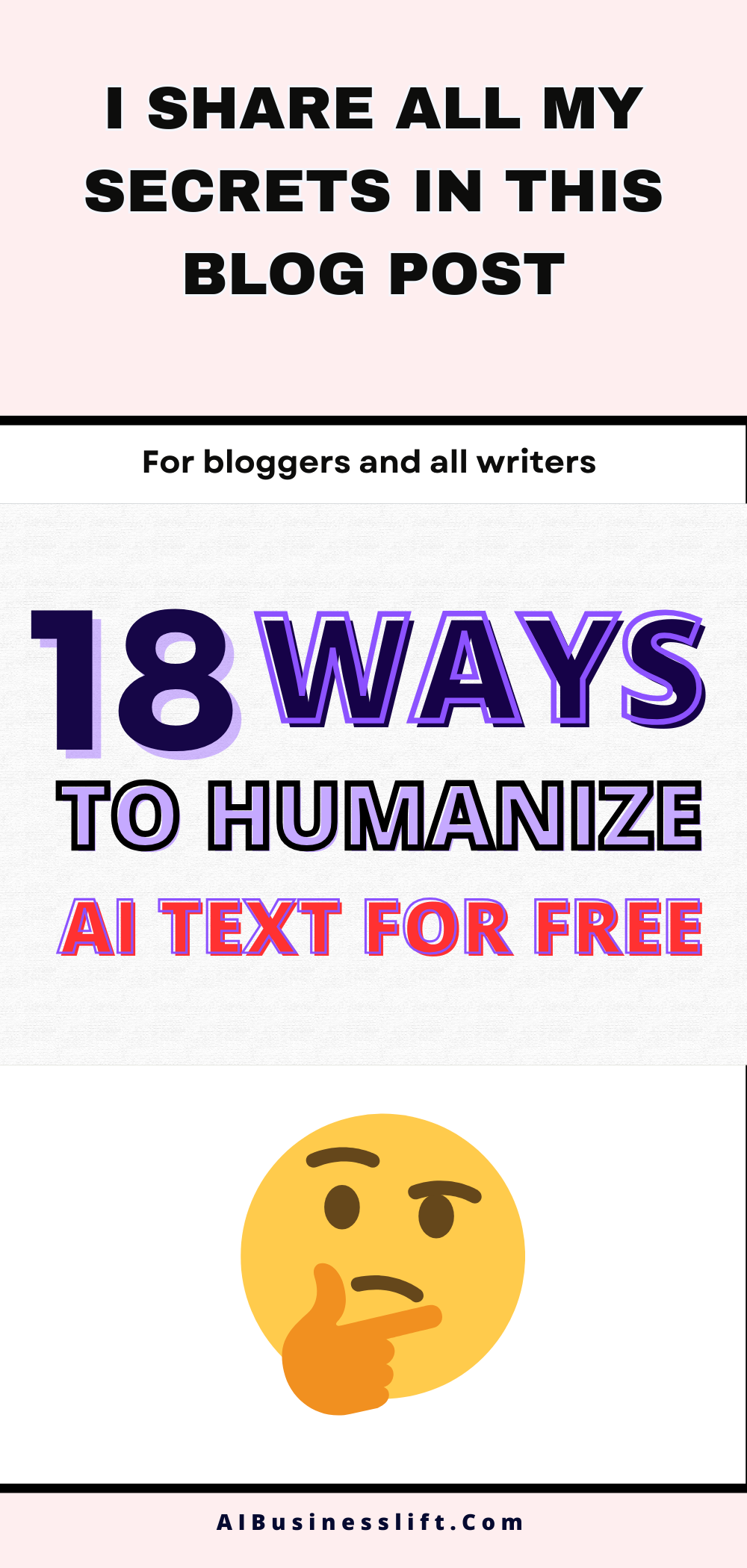
Je suis très heureux de présenter cet article de blog.
Parce que j'utilise l'IA dans mes articles de blog pour écrire et je fais TOUJOURS beaucoup d'édition pour l'humaniser.
Nous sommes à l'ère de l'intelligence artificielle (IA). Chaque entrepreneur et créateur de contenu devrait utiliser l'IA pour rester compétitif.
J'irai même plus loin : tout le monde doit apprendre à utiliser l’IA.
Mais les algorithmes et la plupart de votre public n'apprécieront pas que votre contenu semble écrit par une IA.
Que devrions-nous faire ? Que devriez-vous faire ?
À ce stade, les gens qui ne comprennent toujours pas que l’IA est un outil diront : « Vous voyez ? Utiliser l'IA est une mauvaise chose. Cela produit du contenu de mauvaise qualité et du spam. L'IA ne remplacera jamais les humains. Je n'utilise jamais l'IA et je suis du bon côté de l'histoire. »
D'accord, certains le disent avec leurs propres variantes, mais c'est toujours dans ce sens.
C'est maintenant le moment où je dis qu'ils ont tort et je vous le prouve.
Je plaisante. Ces affirmations ne sont pas totalement fausses, mais elles offrent un point de vue limité, ce qui les rend fausses.
Ok ok, je vais arrêter de jouer au détective et vous donner une explication plus claire.
À l'heure actuelle, l'IA produit du contenu robotisé de faible qualité. Il n'est pas destiné à être le produit final, en particulier pour les blogs, les livres numériques et autres contenus longs.
Il faut l'associer à la créativité humaine en procédant à un montage approfondi. C'est ce qu'on appelle humaniser le contenu IA.
Table des matières
BasculerQue signifie humaniser le contenu de l’IA ?
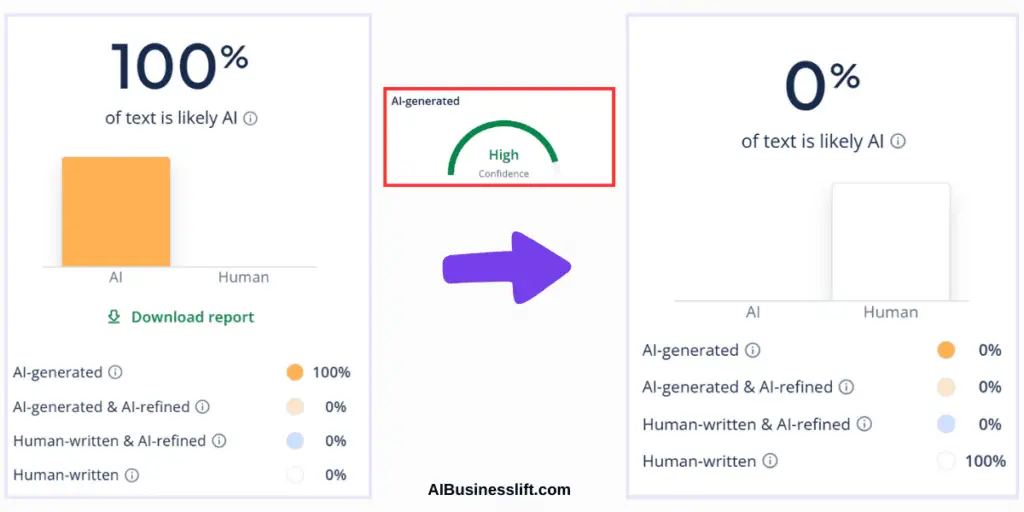
Humaniser le contenu généré par l'IA signifie rendre le texte généré par l'IA plus naturel, engageant et personnel, comme s'il avait été écrit par une personne réelle. Cela le rend plus accessible aux algorithmes et moins susceptible d'être détecté par les détecteurs d'IA.
Vous pouvez réellement générer du texte IA et le modifier jusqu'à ce qu'il sonne 100% humain, au point qu'il soit aussi naturel que quelque chose écrit sans IA.
C'est ainsi que vous obtenez le contenu parfait et c'est ainsi que les écrivains sont censés écrire à l'ère de l'IA.
Cet article de blog vous apprendra tout ce que vous devez savoir sur : Comment convertir du contenu IA en contenu humain ? Comment humaniser manuellement du contenu IA ? Comment rendre un contenu non détectable par l'IA ?
Le résumé de ce qui va suivre est que vous devez tirer le meilleur parti des deux : des générateurs de texte IA et de vos compétences humaines.
Cette introduction était longue mais je crois qu'elle était nécessaire pour poser les bases de ce que je vais vous enseigner.
Je vais vous donner de nombreux conseils dont vous n'avez jamais entendu parler sur la façon de transformer le contenu généré par l'IA en quelque chose qui ressemble à 100% écrit par un humain.
18 façons d'humaniser gratuitement un texte IA
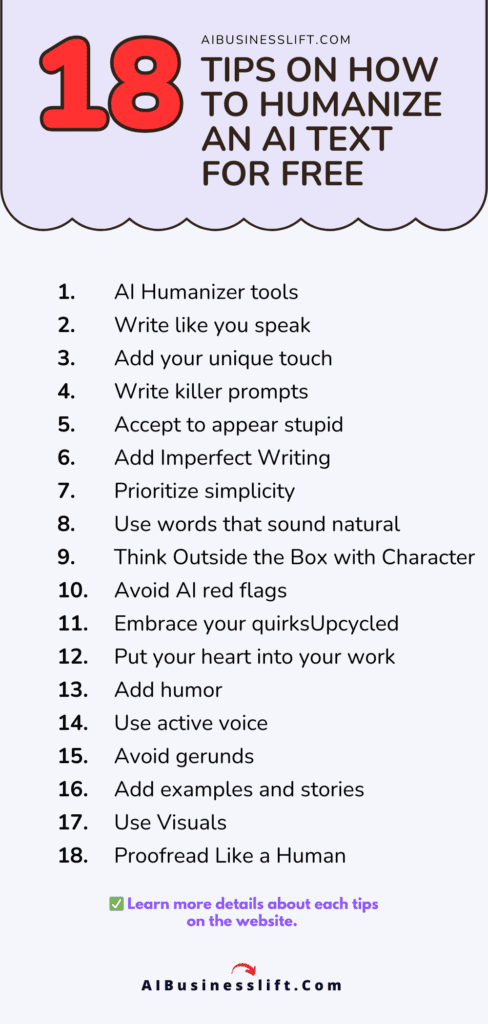
Une bonne façon de soutenir mon travail acharné est d'épingler ceci sur Pinterest Plz.🥹Merci !
1. Les outils AI Humanizer fonctionnent-ils ?
Pour humaniser le texte généré par l'IA, vous pouvez utiliser des outils en ligne tels que L'humaniseur d'IA de Scribbr, l'IA de Writesonic ou WriteHuman.ai.
Vous pouvez commencer à les utiliser avec leur forfait gratuit, ils sont tous célèbres.
J'ai donc demandé à l'IA d'humaniser cette phrase générée avec ChatGPT :
“Démarrer une entreprise implique de nombreux défis, notamment l’obtention de financements, le développement d’un produit viable, la recherche de membres d’équipe fiables, l’établissement d’une présence sur le marché et la gestion du stress constant de l’incertitude tout en maintenant un équilibre entre vie professionnelle et vie privée.“
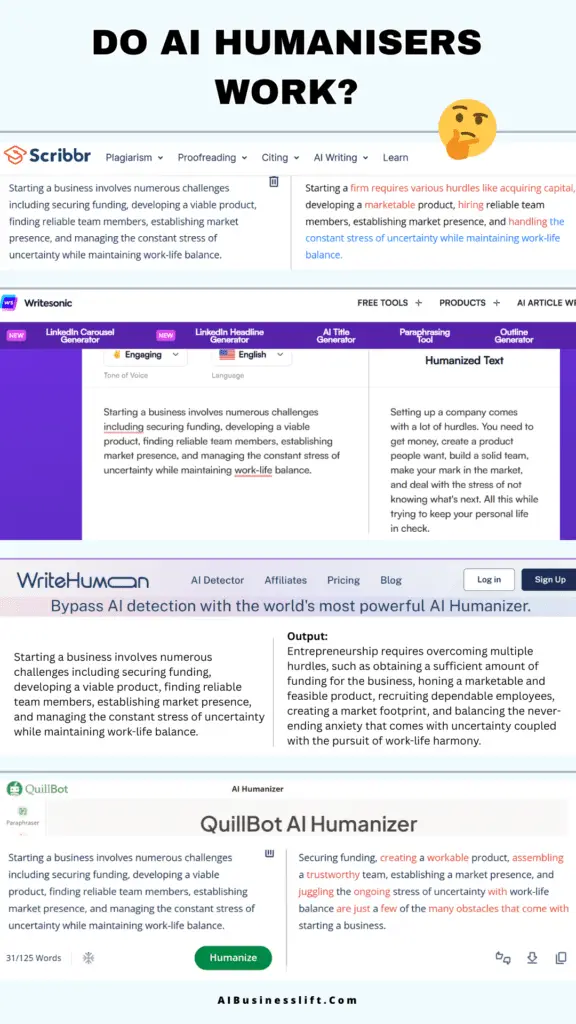
Les humanisateurs d’IA fonctionnent-ils ?
Malheureusement, ils sont tous mauvais. Je ne fais pas confiance aux humanisateurs d'IA. J'ai fait ce test en 2025, et pour l'instant, la technologie d'humanisation d'IA a encore un long chemin à parcourir.
Mais, pour être honnête, le résultat de Writesonic n'est pas mauvais. Mis à part les « obstacles », les humanisateurs doivent simplifier ces modèles d'IA complexes, et non compliquer les choses.
Si j'humanise cette phrase manuellement, voici le résultat :
“Créer une entreprise implique de nombreux défis, comme trouver un financement, un bon produit, une équipe performante et se faire connaître. Sans oublier le stress que vous subirez tout en essayant de concilier vie professionnelle et vie privée.“
2. Écrivez comme vous parlez (utilisez un ton conversationnel)
Vous avez donc utilisé ChatGPT, Claude AI, Jasper ou un autre outil d'IA, et le détecteur de contenu IA indique : Bip bip bip, votre contenu est généré par l'IA 100%.
Tout ce que vous avez à faire est relisez-le et imaginez que c'est quelque chose que vous avez écrit.
Lorsque vous tombez sur un mot ou une phrase qui ne ressemble pas à quelque chose que vous utiliseriez un jour, remplacez-le par ce qui vous semble naturel.
Et continuez à faire cela encore et encore pour tout le contenu.
À la fin, vous vous débarrasserez de toute trace d’IA et aurez quelque chose qui semble parfaitement écrit par un humain.
Vous devez être capable de faire clairement la distinction entre le contenu de l’IA et le contenu humain pour que cela fonctionne.
Demandez-vous :
- Comment est-ce que je parle ou j'écris habituellement quand je suis moi-même ?
- Comment parler à mes amis ?
3. Ajoutez votre touche unique
Chacun est unique ; il y a des choses que l'IA ne peut pas faire pour nous. Je parle de votre opinion personnelle, de votre perspective unique, de votre expérience personnelle, de votre mémoire.
Lorsque vous ajoutez ces éléments, vous vous connectez à votre public et rendez votre contenu original.
Vous pouvez vous aider avec ces questions :
- Ai-je donné une histoire qui illustre ce point ?
- Suis-je d’accord ou non avec cette sagesse conventionnelle ?
- Puis-je faire référence à des conversations, des étudiants, des situations ou des moments liés à cela ?
- Quelles émotions ressens-je réellement à ce sujet ? Et comment puis-je les exprimer avec authenticité ?
- Quels détails seule une personne ayant mon expérience pourrait-elle connaître ?
- Comment est-ce que je veux que mon public se sente après avoir lu ceci ?
4. Écrivez des invites percutantes
Le squelette de mon article de blog contient plus de 600 mots.
Cela signifie que ce n’est pas juste un simple “Écrivez un article de blog sur ce sujet, sur ce ton, pour X mots.”
Bravo pour ces détails, car certains ne vont pas plus loin. Mais c'est quand même la réponse moyenne, et ce n'est pas suffisant.
Lorsque j’écris un article de blog, j’explique en détail à l’IA comment mettre en œuvre tout ce que je dis ici.
Je donne l'IA une identité, je le dis qui est mon public, les problèmes, les solutions, le plan, les mots-clés, la nuance à utiliser, le ton, la longueur, les mots à ne pas utiliser, les émotions. Eh bien, peu importe ce que vous voulez, je passe par tout.
C'est pourquoi mon message de blog est très long et plus j'acquiers de l'expérience, plus il devient long.
C’est ce à quoi vous devriez aspirer.
Utilisez ce que vous avez appris ici pour écrire des sujets percutants. Ceci, mon ami, est le début du processus d'humanisation.
5. Accepter de paraître stupide

L'IA s'efforce d'atteindre la perfection, mais nous, les humains, savons que nous sommes loin d'être parfaits et ce n'est pas grave, cela fait partie de notre beauté.
Voici quelques phrases que l’IA utilise rarement dans les articles de blog, mais qui peuvent donner à votre contenu une impression véritablement humaine :
- Je ne sais pas.
- J'ai fait une erreur.
- Opinion impopulaire…
- Au début, je pensais à X, puis j'ai découvert Y.
- Je me suis complètement trompé à propos de…
- J'ai changé d'avis à ce sujet...
- Cela peut paraître stupide, mais…
- Croyez-moi, j’ai tout essayé avant de comprendre ça…
On sent la lutte humaine dans ces lignes. On y voit des essais et des erreurs. On admet qu'en tant qu'humain, on ne sait pas tout.
Je ne sais pas ce que vous en pensez, mais c'est logique, non ? L'IA est rarement confuse dans son raisonnement.
6. Ajouter une écriture imparfaite
Comme je vous l'ai dit, l'IA est Monsieur Parfait. Quand vous ajouter des modèles incohérents vous allez plus loin que le contenu généré par l'IA.
Par exemple, écrivez parfois «ne le faites pas" et d'autres fois "ne pas.”
Mélangez des phrases très courtes avec des phrases plus longues. Comme ça.
Montrez votre enthousiasme avec la ponctuation !!! Est-ce que tu comprends ???
Briser intentionnellement les règles de grammaire. Parfois, vous pouvez commencer des phrases par «Et" ou "Mais” L'IA les place généralement au milieu d'une phrase puisque c'est la règle.
Mais nous ne sommes pas une IA, brisons quelques règles.
Finalement, j'ai vu un blogueur dire qu'il intentionnellement inclut des fautes de grammaire dans ses écritsC'est un exemple de ce que nous enseignons ici, car c'est une autre chose que l'IA n'est pas programmée pour faire par elle-même.
Mais je ne le recommande pas. Il est important de rester professionnel. N'est-ce pas ? Je veux dire, n'est-ce pas ???
7. Privilégiez la simplicité
L'écriture de l'IA choisit souvent l'option la plus complexe car elle sonne « f »normal, mais les vraies personnes utilisent généralement smots plus simples à moins qu'ils essaient de paraître intelligents.
En utilisant langage courant rend votre écriture plus authentique.
Par exemple
- « De plus » → utiliser « également »
- « Néanmoins » → utiliser « mais »
- « S'efforcer » → utiliser « essayer »
- « Suffisant » → utiliser « assez »
- « Obstacle » → utiliser « difficulté »
Un autre conseil est de utilisez des phrases plus courtes.
Style IA :
« Créer une entreprise comporte de nombreux défis, comme obtenir un financement, développer un produit viable, trouver des membres d'équipe fiables, établir une présence sur le marché et gérer le stress. »
Ce que les humains préfèrent :
« Démarrer une entreprise comporte de nombreux défis, comme obtenir un financement et développer un produit viable.
Vous devez également trouver des membres d’équipe fiables, établir une présence sur le marché et gérer le stress. »
Je le divise simplement en 2 phrases pour le rendre facilement digeste.
8. Utilisez des mots pour rendre le contenu de votre blog naturel
Insérer des mots de remplissage verbaux : Bon, alors, de toute façon, regarde. Habituellement au début d'un paragraphe.
Vous pouvez même être libre et faire des choses comme ceci :
« Alors, es-tu prêt à ce que je te dise ce qui se passe LE MEILLEUR restaurant en France ? »
Vous voyez la façon dont j'ai écrit «Donc" et "Le meilleur« ? » Cela vous distingue vraiment. Cela donne une touche humaine à votre article.
Utilisez des pronoms personnels : «je" et "Toi".
9. Sortez des sentiers battus avec du caractère
Soyez inventif, soyez libre d'esprit. Je vais vous expliquer cela à travers une étude de cas.
Le passage suivant est de Ling, auteur du Blog Finsavvypanda. Veuillez noter attentivement la partie que j'ai mise audacieux:
Donc, Je vais continuer à insister là-dessus jusqu'à ce que ça soit gravé dans ta tête. :
Peu importe que vous ayez un ou cent articles de blog. Si vous ne créez pas régulièrement du nouveau contenu et ne le publiez pas, tu ne vas pas « Obtenez du trafic depuis Pinterest, sinon votre trafic risque de commencer à en souffrir. »
Arrêtez d'être perfectionniste (….)
Certains de ces perfectionnistes ne créent que quelques articles de blog, puis s'arrêtent complètement parce qu'ils s'épuisent à essayer de visez un matériel A++ alors que tout ce dont vous avez vraiment besoin est un B pour l'instant. Comme je l'ai dit plus tôt, ce qui est bien est assez bien.
La partie en gras montre comment elle est catégorique, exprime sa personnalité, et avec l'exemple A++ et B, elle invente librement ses propres exemples (métaphore).
En formulant « Le bien est suffisant », elle a créé sa propre citation. C'est une signature dont nous nous souviendrons.
Ling sort constamment des sentiers battus avec ses personnages. C'est une excellente façon d'écrire un contenu humain qui touche les lecteurs.
Pas étonnant qu'elle gagne au moins 19 000 000 TP par mois grâce à son blog. Poursuivez votre lecture ; de nombreuses autres études de cas de blogueurs à succès sont à venir.
10. L'IA signale les mots à éviter
Les modèles linguistiques de l'IA ont tendance à abuser de certains mots. Sans même que nous nous en rendions compte, ces mots sont devenus des indicateurs que votre contenu était généré par l'IA.
Il vous suffit donc d’éviter de les utiliser.
Voici ma liste de mots d'alerte de l'IA à éviter :
Améliorer, exploiter, plonger dans, plonger dans, favoriser, élever, libérer, déverrouiller, idées, voyage, présenter, de manière transparente, rationaliser, créer, naviguer, royaume, révolutionnaire, captivant, testament, assurer, parfait pour, tapisserie, de même, embarquer, s'efforcer, dans le monde dynamique de, paysage, innovant, conduire, dans le paysage en constante évolution de, impliquer, à travers, façonner, dans le royaume de, embarquer.
11. Acceptez vos bizarreries
– Qu'est-ce qu'une bizarrerie ?
Les bizarreries sont des habitudes, des comportements ou des traits inhabituels qui rendent une personne unique.
-Des exemples de bizarreries ? Voici quelques exemples :
- Toujours en train de mâcher du chewing-gum (L'entraîneur du Real Madrid Carlo Ancelotti)
- Avoir un rire distinctif (les gens dans Une pièce)
- Porter toujours un type de vêtement spécifique (une personne de la sous-culture gothique)
- Apporter des collations partout (Choji dans Naruto).
Ne vous souciez pas de mes exemples. L'objectif est de s'assurer que tous les lecteurs comprennent le concept de bizarreries.
Ici, il n'y a que 2 questions à se poser :
Avez-vous des particularités ? Pouvez-vous les utiliser dans votre blog ?
– Exemples de bizarreries dans les blogs
Ne vous inquiétez pas si vous manquez d'idées. Je vais vous donner quelques exemples de particularités propres aux blogueurs.
Il existe des particularités positives qui peuvent donner plus de personnalité à votre style d'écriture et vous démarquer de l'écriture IA.
Mélanger les lettres minuscules et MAJUSCULES est une particularité d'écriture distinctive.
Il montre une variation de ton d’une manière que l’IA évite généralement.
Quand tu écris "c'est LITTÉRALEMENT la meilleure chose qui soit” ou "JE NE PEUT PAS crois que c'est arrivé", ça se démarque.
Le blogueur à succès Mia du blog Elle rêve toute la journée a cette particularité.
Elle a également une deuxième particularité qui est simple mais très rarement utilisée dans les blogs.
Elle comprend réflexions complémentaires entre parenthèses de temps en temps.
Par exemple:
- J'aime tout faire moi-même (Je suis aussi concepteur de sites Web).
- Épinglez de manière cohérente et stratégique pour générer du trafic vers votre nouveau blog (J'utilise Tailwind pour planifier les pins).
- Engagez-vous à publier au moins un article de blog par semaine et procurez-vous un calendrier de contenu (oh, et tiens-toi-y mdr).
Elle n'en abuse pas.
12. Mettez du cœur dans votre travail
Une autre façon de le dire est : écrivez avec votre cœur.
Jeff Rose est un autre blogueur à succès qui réalise plus de $50 000 par mois de revenus grâce à son De bons centimes financiers blog.
Le succès de ce site peut être attribué au fait que son auteur a connu des difficultés financières à un jeune âge, car ses deux parents étaient aux prises avec des dettes.
Son contenu vient donc du cœur. Il est si authentique qu'il ne peut manquer de toucher son public cible.
Lorsque vous humanisez votre blog, être dans un état d'empathie.
Ce que vous voyez doit d'abord vous convaincre de sa valeur et de son utilité. Si vous n'êtes pas convaincu que votre article de blog vous serait utile si vous cherchiez ce sujet, il ne convaincra pas non plus les autres.
Modifiez-le jusqu'à ce que vous soyez entièrement satisfait au point que vous oseriez le montrer à un expert dans votre niche.
13. Ajoutez de l'humour
Faire des blagues est un trait humain que les gens apprécient.
À partir d'une invite sans contexte, voici trois blagues que l'IA m'a données :
Pourquoi le site est-il allé en thérapie ?
Il y avait trop de problèmes !
Pourquoi les robots n’ont-ils jamais peur ?
Parce qu’ils ont des nerfs d’acier !
Pourquoi le freelance a-t-il apporté une horloge à la réunion ?
Parce que le temps c'est de l'argent !
Ok… Je vois que ça fait un effort, mais honnêtement, ce n’est pas aussi drôle qu’un humain qui parle avec un ton humoristique.
Je ne suis pas doué pour les blagues, mais si vous savez faire des blagues qui touchent, alors faites-le de temps en temps. Sinon, c'est facultatif.
14. Utilisez la voix active
L'IA a tendance à utiliser beaucoup de voix passive. Supprimez-les.
La voix active rend les phrases plus claires.
Par exemple
❌ Le projet a été réalisé par l'équipe. (Voix passive)
✅ L'équipe a terminé le projet. (voix active)
Vous voyez la différence ? Le deuxième est plus facile à lire.
15. Évitez les gérondifs
Les gérondifs sont des verbes se terminant par -ing qui agissent comme des noms (par exemple, en cours d'exécution, en lisant).
L’IA aime les utiliser au début des phrases.
C'est injuste, mais les phrases commençant par un gérondif sont aujourd'hui considérées comme des signaux d'alarme en matière de contenu IA. Beaucoup de gens l'ignorent.
L’IA change littéralement la relation que nous entretenons avec l’écriture. Assez triste !
Par exemple
❌ En cours d'exécution chaque jour est important.
✅ Tu devrais courir tous les jours.
16. Ajoutez des exemples et des histoires
Vous avez probablement remarqué que j’ai utilisé de nombreux exemples dans cet article de blog, tout comme les blogueurs à succès.
J'ai lu de nombreux livres numériques de développement personnel et regardé de nombreuses interviews. Les livres numériques et les intervenants à succès illustraient toujours leurs propos par des exemples. Ce sont de grands conteurs.
Dans le blogging, c'est pareil. Beaucoup de débutants commettent l'erreur de se contenter de donner des faits, des conseils et des informations pédagogiques. L'IA fait la même chose.
Mais la façon dont vous partagez l’information est ce qui fait la différence entre un engagement élevé et un engagement faible.
Soyez clair. Stimulez l'imagination du lecteur avec exemples et histoires.
17. Utilisez des éléments visuels
Intégrer images, infographies, tableaux ou vidéos pour compléter le texte.
Les visuels rendent le contenu plus attrayant et aident à illustrer efficacement les points.
Cela vous distinguera des autres utilisateurs de contenu IA. Vous gagnerez tellement l'adhésion de l'algorithme et de vos lecteurs que l'aspect IA disparaîtra.
Je considère les visuels comme faisant partie du processus d'humanisation du contenu de l'IA. L'environnement de votre contenu écrit est important, car il peut le rendre de haute ou de basse qualité.
18. Relisez comme un humain
– Qu’est-ce que la relecture ?
La relecture est la dernière étape de l'édition lorsque vous vérifiez votre contenu avant qu'il ne soit publié ou partagé.
Lors de la relecture, vous recherchez :
- Erreurs d'orthographe
- Erreurs grammaticales
- Problèmes de ponctuation
- Problèmes de formatage
- Incohérences
- Tout ce que vous auriez pu oublier
Et pour toutes ces choses, l’IA et les humains les font différemment.
– Comment relire votre contenu IA ?
Vous devez faire le montage final normal mais aussi revérifier certains éléments :
Supprimez les phrases et les structures répétitives.
L'IA n'ajoute pas de transitions entre les paragraphes, ou quand elle le fait, c'est ennuyeux comme “En outre“; remplacez-les par des connexions naturelles.
Par exemple Voilà le truc/Mais attendez, il y a plus/La meilleure partie ?
Décomposez les longues phrases.
Réduire la présence de tirets cadratins (—). L’IA génératrice de texte les utilise de manière excessive.
Réduisez les virgules. L’IA les utilise trop.
Encore une chose : ajouter une virgule avant “et/ou“ C'est facultatif, mais l'IA l'ajoute TOUJOURS à une liste. Je préfère donc le supprimer.
Par exemple
« Tu devrais savoir que*,** un « petit-déjeuner très américain » combine : céréales, crêpes, gaufres, pain perdu, œufs, bacon, saucisse, galettes de pommes de terre, lait, café**,** et jus d'orange.
Dans cet exemple, si je veux réduire les virgules, je supprimerai celle qui suit. “que“ et celui d'avant “et.“ Croyez-moi, cela fait une grande différence lorsque vous avez un long texte.)
Gardez à l’esprit que l’étape de relecture est la partie où vous vous assurez que tous les conseils que nous avons donnés ici et que vous souhaitez utiliser sont appliqués.
Utiliser l’IA pour l’écriture créative est-ce de la triche ?
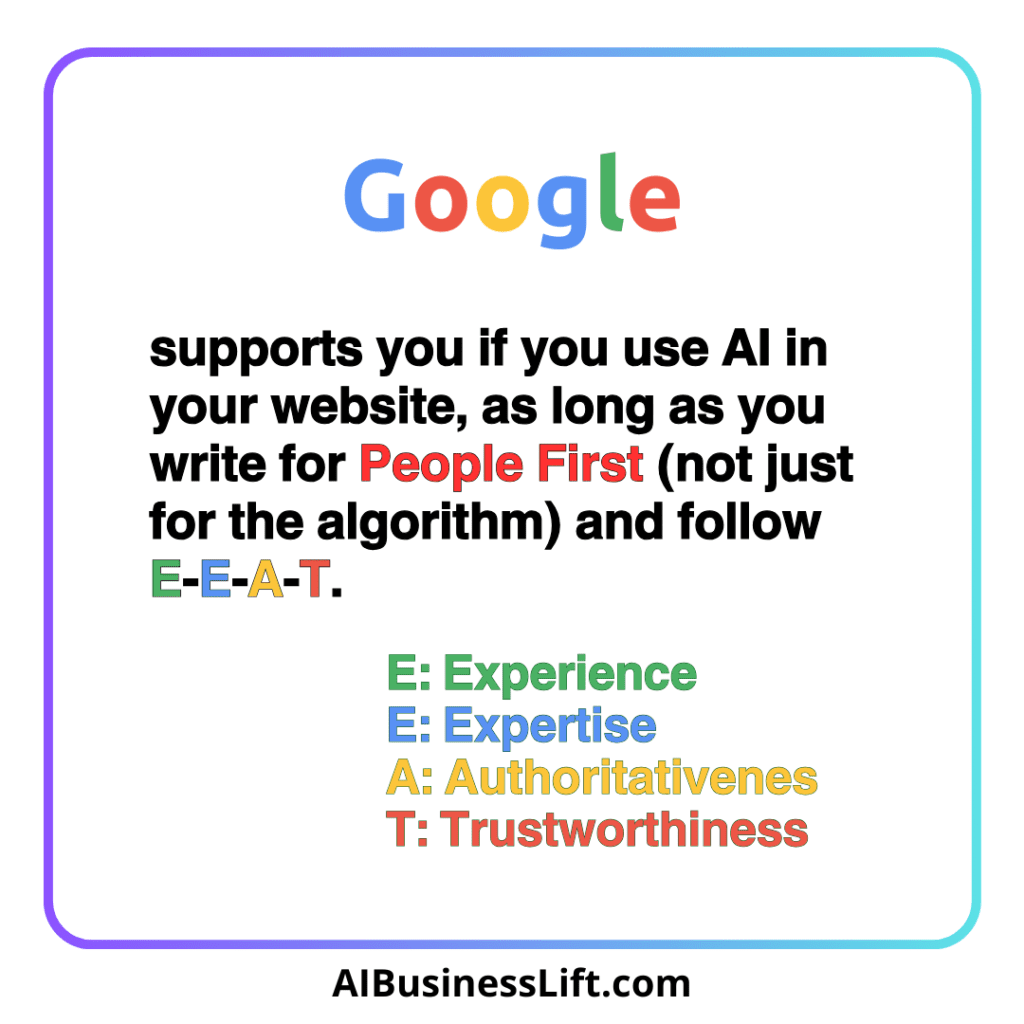
La tricherie est l’acte d’être malhonnête, d’enfreindre les règles, d’être trompeur ou d’utiliser des moyens contraires à l’éthique pour atteindre un objectif ou un avantage.
Partout où vous utilisez l'IA QUAND CE N'EST PAS AUTORISÉ, c'est de la triche, que ce soit à l'école ou au travail.
AIBusinessLift valorise l'éthique, nous sommes donc contre l’utilisation malhonnête de l’IA.
Mais l’utilisation de l’IA dans l’écriture créative est généralement autorisée. Google accepte pleinement l'IA, comme le font UNESCO et la plupart des pays. Utilisez-le simplement avec éthique.
Si vous travaillez à votre compte, tant que vous acceptez l'utilisation de l'IA, vous êtes libre de l'utiliser à votre guise. Ce n'est pas de la triche.
Si vous travaillez avec une équipe, un collaborateur, un supérieur hiérarchique ou un client, assurez-vous qu'ils acceptent que vous utilisiez l'IA. Sans leur autorisation, vous trichez.
Il y a principes éthiques à respecter lorsque vous utilisez l'IA dans des œuvres créativesL’une d’entre elles consiste à informer toutes les parties concernées que vous utilisez l’IA.
Si vous avez d’autres questions sur l’utilisation éthique de l’IA ou sur quoi que ce soit d’autre, posez-les-moi dans la section commentaires ou sur les réseaux sociaux.
J'ai fait ma thèse sur ce sujet, j'ai donc un point de vue d'expert.
Si vous êtes curieux de connaître mes différentes utilisations de l'IA, j'ai un article de blog où je l'explique en détail comment j'utilise l'IA dans mes articles de blog.
Ma dernière pensée
Les conseils partagés ici peuvent vous aider à éviter les pénalités des moteurs de recherche et des détecteurs d’IA.
Humaniser le contenu IA est essentiel pour créer du contenu original et engageant. Le secret réside dans une édition soignée.
Tant que vous intégrez des touches personnelles, utilisez la voix active, des particularités et les autres conseils époustouflants que j'ai partagés, vous pouvez produire du contenu qui résonne auprès de votre public.
Parler naturel est une science, mais être authentique et utile aux lecteurs est une chose à laquelle il faut prêter une attention particulière. C'est votre GPS !
N’oubliez pas que l’IA est un outil pour vous aider, mais c’est le facteur humain qui donne véritablement vie au contenu.
Articles similaires :
- Comment utiliser l’IA pour écrire des articles de blog de type humain ? – Guide pour un contenu unique
- 10 façons d'utiliser l'IA dans les blogs
- Pouvez-vous utiliser l'IA pour rédiger des articles de blog : Changements du paysage SEO et EEAT
- 12 façons de gagner de l'argent en écrivant avec l'IA
- Comment surmonter les doutes sur votre réussite en tant que blogueur en difficulté



